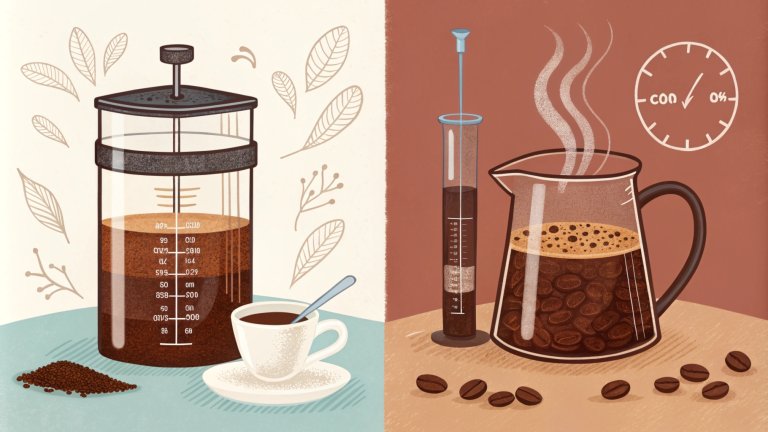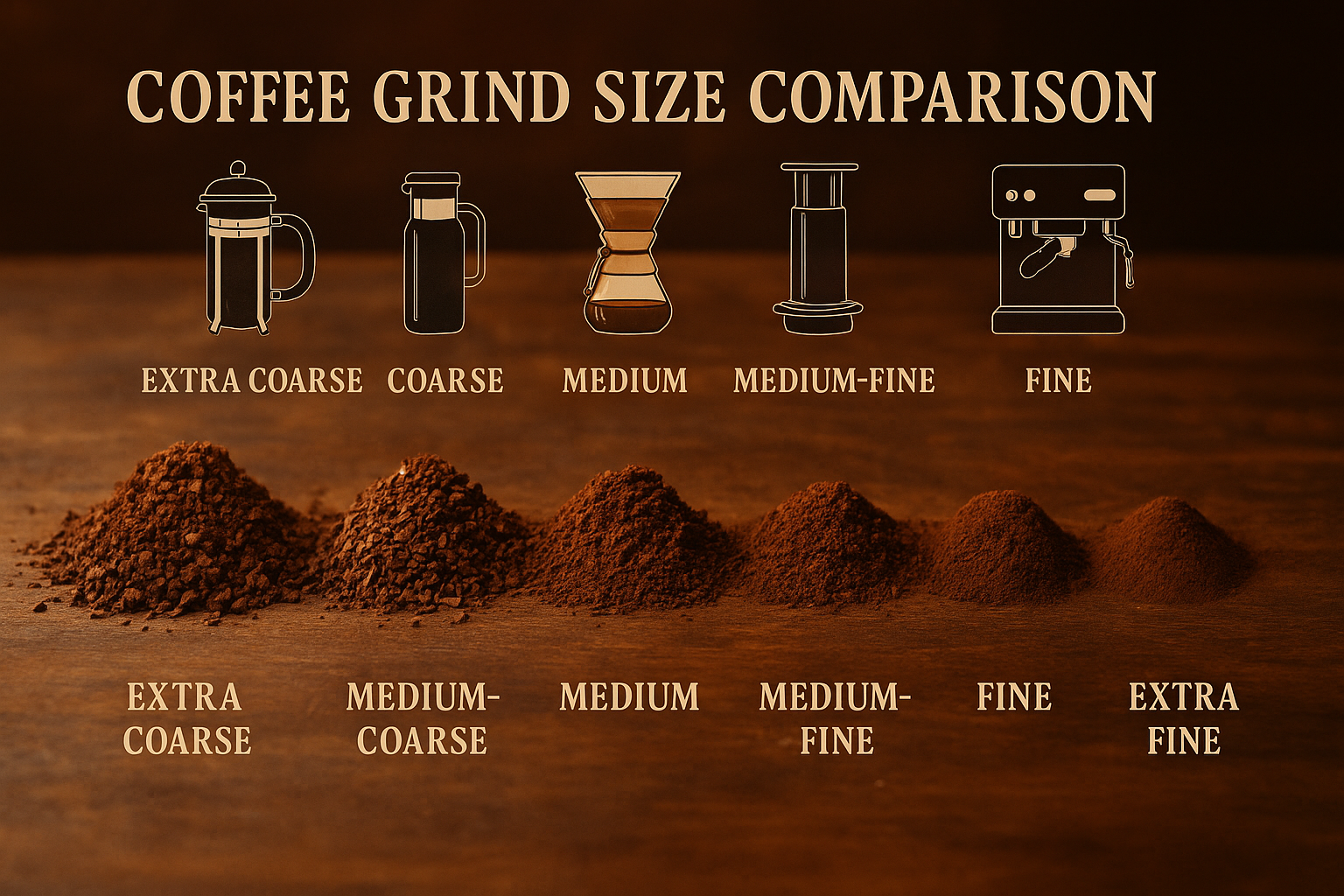
Getting the perfect cup of coffee starts with one key step. You need the right coffee grind size. This simple choice makes or breaks your morning brew. Too fine? You get bitter coffee. Too coarse? Your coffee tastes weak and sour.
This guide shows you exactly which grind size for brew methods works best. You’ll learn how to match your coffee grind size chart with your favorite brewing style. No more guessing. No more bad coffee.
Why Grind Size Matters in Coffee Brewing
Your coffee grind size controls how water meets coffee. Think of it like this. Fine grinds are like flour. Water touches every tiny piece fast. Coarse grinds are like sea salt. Water takes time to reach inside each chunk.
Coffee extraction happens when hot water pulls flavors from ground beans. The size of your grounds changes how fast this happens. Grind size for espresso needs to be very fine because water touches grounds for just 25-40 seconds. Grind size for French press should be coarse because coffee steeps for 4-5 minutes.
Impact on Flavor, Extraction, and Brewing Time
Surface area makes the magic happen. When you cut a coffee bean in half, you create more surface area. More surface means faster flavor extraction. This is why:
The golden rule is simple. Short brewing time needs fine grinds. Long brewing time needs coarse grinds.
Comprehensive Coffee Grind Size Chart (All Brew Methods)
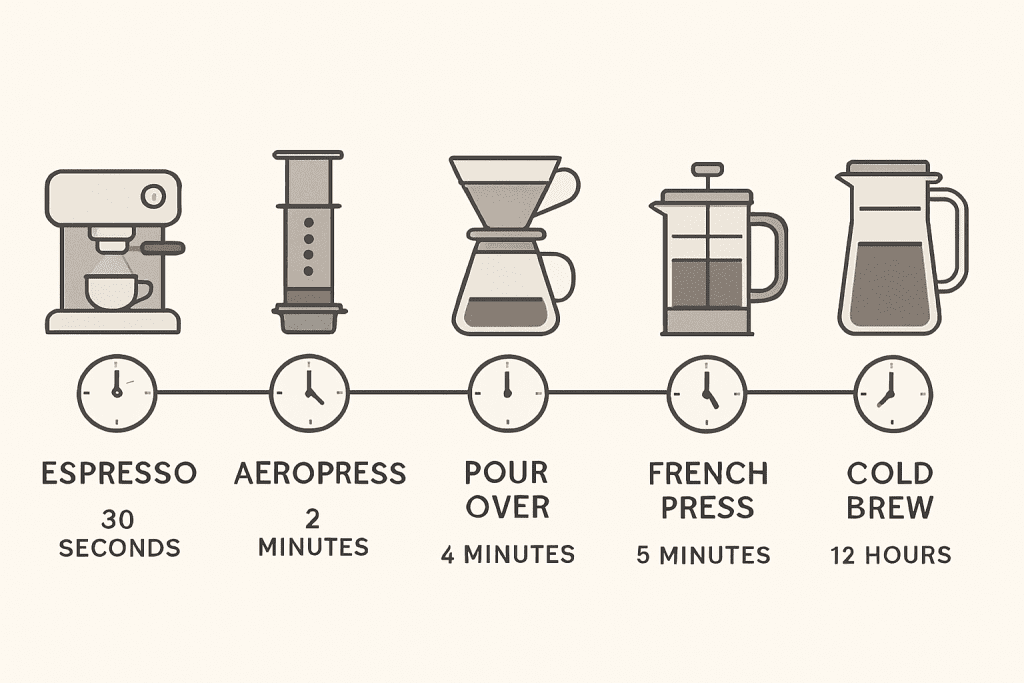
Visual guide showing grind sizes from extra coarse to extra fine with micron measurements and best brewing methods
Here’s your complete coffee grind guide with exact measurements. Each grind size works perfectly with specific coffee brewing methods.
Visual Grind Size Guide: From Extra Coarse to Extra Fine
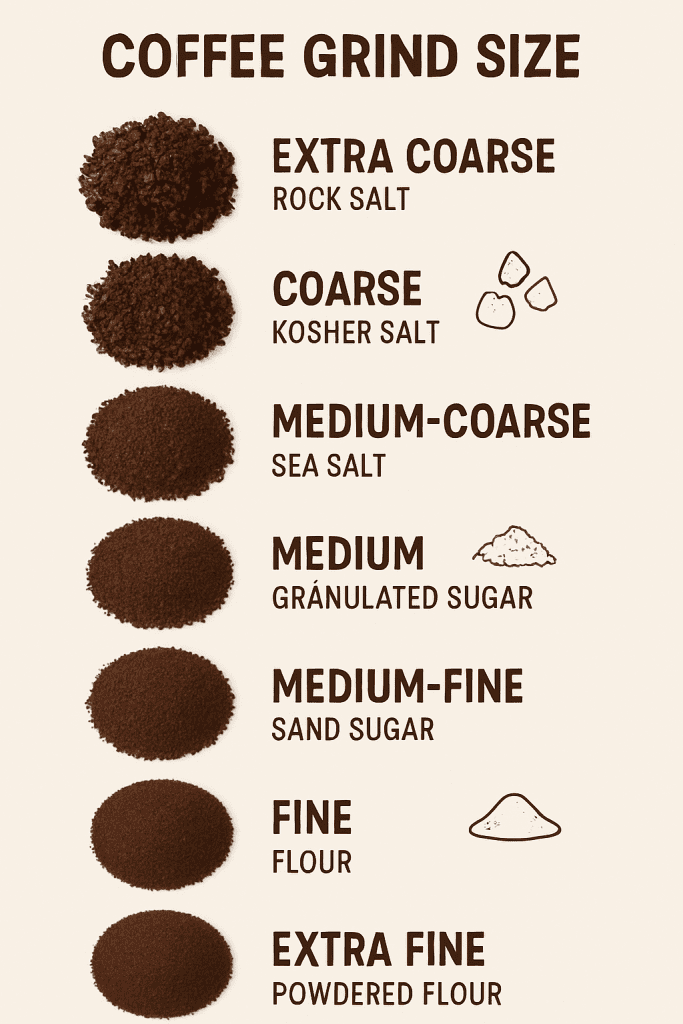
Think of grind sizes like kitchen ingredients you know:
Coffee grind consistency matters more than you think. A burr grinder creates uniform particles. A blade grinder makes random chunks and dust. This is why your coffee tastes different every time with blade grinders.
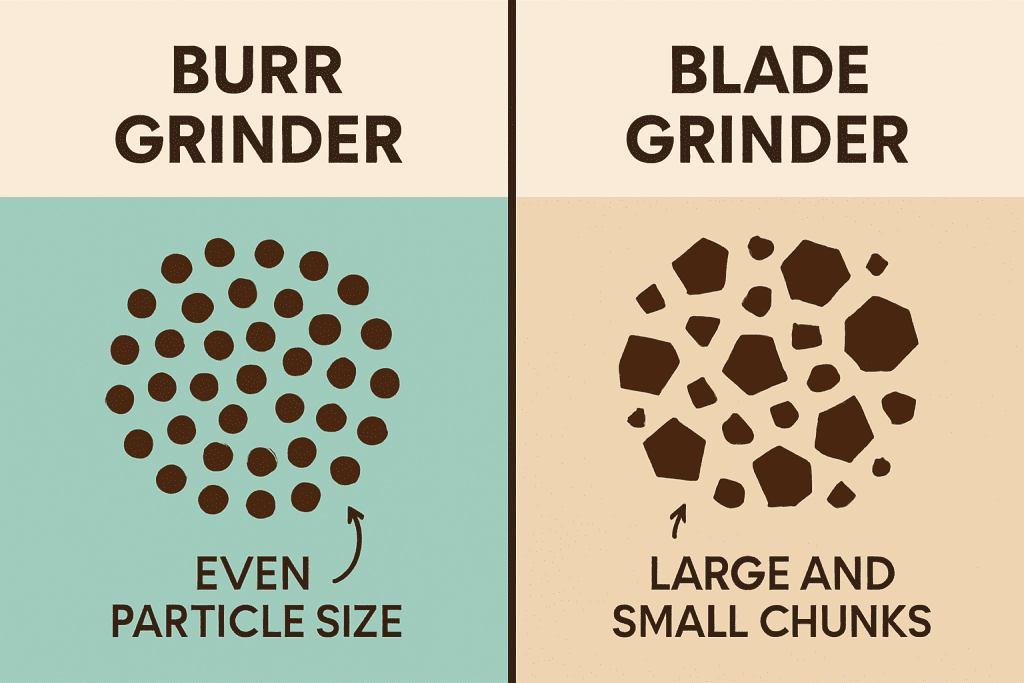
How to Choose the Right Grind Size for Your Brew Method
Step-by-Step Selection and Adjustment Guide
Start with this simple process:
- Pick your brewing method from the chart above
- Set your grinder to the recommended size
- Taste your coffee after brewing
- Adjust grinder based on taste:
- Too bitter? Go coarser
- Too sour or weak? Go finer
- Make small changes – tiny adjustments create big flavor differences

Grind adjustment works like a volume knob. Small turns make big changes. Light roasts often need slightly finer grinds. Dark roasts work better with slightly coarser grinds.
Real Customer Scenarios: Grind Size Success Stories & Mistakes
Scenario 1 – Home Barista’s Espresso Quest
Sarah bought her first espresso machine and wondered why her shots tasted terrible. She used pre-ground coffee (medium grind) instead of fine grind. Her shots pulled in 10 seconds instead of 25-40 seconds. The coffee was sour and weak.
The fix: She switched to fine grind and dialed in her shots. Now her espresso takes 30 seconds and tastes rich and balanced.
Scenario 2 – Café Owner’s Drip Consistency Challenge
Mike’s café served inconsistent drip coffee. Some cups were bitter, others weak. The problem? His blade grinder created uneven particles. Fine dust over-extracted (bitter). Large chunks under-extracted (weak).
The fix: He upgraded to a burr grinder. Now every cup tastes the same because every grind is uniform.
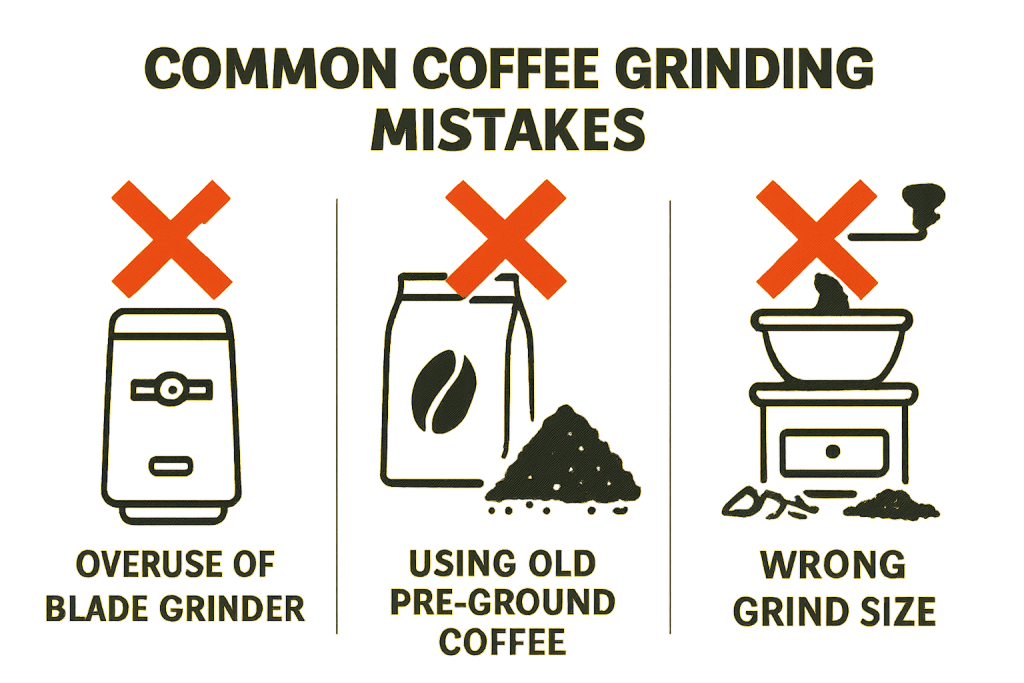
Common Mistakes to Avoid
Cost Breakdown – Grinders & Brewing Tools
Smart coffee lovers invest in good grinders. Here’s what you can expect to spend:
Ongoing Maintenance and Hidden Costs
Burr grinder maintenance includes:
Blade grinder costs seem lower upfront. But inconsistent grinds waste expensive coffee beans. You throw away bad-tasting cups and use more coffee to get decent flavor.
Coffee Grind Eligibility Checklist & Quick Calculator
Is Your Grind Size Right? Self-Assessment Steps
Taste Test Checklist:
Visual Check:
Brewing Performance:
Interactive Brew Method Calculator
Use this simple formula for any brewing method:
Timeline Expectation – From Beans to Brew Perfection
Calibration Timeline: Grinder Setup to Flavor Optimization
Week 1: Learn your grinder settings and basic adjustments
Week 2-3: Fine-tune grind for your favorite brewing method
Week 4: Experiment with different coffee beans and roast levels
Month 2: Master micro-adjustment techniques
Month 3+: Develop palate for subtle flavor changes
Most home brewers find their perfect grind within 2-3 weeks of daily brewing. Professional baristas spend months perfecting their technique. Be patient with yourself.
Alternative Grinding Tools & Methods
Creative Options for Grind Adjustment
When your grinder breaks or you’re traveling:
Hand grinder options work great for travel. They’re quiet, consistent, and need no electricity. Perfect for camping or small kitchens.
Expert Barista Tips for Optimal Coffee Grind Size
Insider Techniques for Consistency & Flavor
Professional secrets for better grinding:
Humidity affects grinding. Wet weather makes beans grind finer. Dry weather makes them grind coarser. Adjust accordingly.
Coffee Grind Size vs. Extraction Comparison
Coffee extraction should hit the sweet spot of 18-22% range. This means water dissolves about one-fifth of your coffee’s mass into flavors you can taste.

Perfect extraction tastes balanced. You get sweetness, acidity, and body in harmony. Under-extraction happens with grind too coarse or brew time too short. Over-extraction happens with grind too fine or brew time too long.
FAQ
What grind size works best for drip coffee?
Medium grind works perfectly for most drip coffee makers. Think table salt texture. This allows 5-8 minutes of brewing time without over-extraction.
Can I use the same grind for all brewing methods?
No. Each method needs its specific grind size. Pour-over grind size differs from French press grind. Using wrong grind size ruins flavor balance.
Why does my coffee taste bitter?
Bitter coffee usually means over-extraction. Try coarser grind, less brew time, or lower water temperature. Blade grinder dust also creates bitterness.
How do I clean my grinder?
Burr grinder cleaning: Remove burrs monthly and scrub with brush. Use grinder cleaning tablets weekly. Blade grinder: Wipe blades and chamber after each use.
What’s the fastest way to adjust grind size?
Make one small adjustment at a time. Test by taste. Stepless grinders offer more precise control than stepped grinders. Keep notes on what works.
Should I buy pre-ground coffee?
Fresh-ground always beats pre-ground. Ground coffee loses flavor in hours, not days. If you must buy pre-ground, use it within one week and store in airtight container.
Why is my AeroPress hard to press?
AeroPress grind size might be too fine. Use medium-fine grind (#4 on scale). Pour water slowly and shake grounds level before brewing.
Final Thoughts & Action Plan for Home Brewers
Perfect coffee starts with understanding your coffee grind size chart. Match your grind to your brewing method. Invest in a quality burr grinder when possible. Practice makes perfect.
Your next steps:
- Identify your favorite brewing method
- Check your current grind size against this guide
- Make one small adjustment and taste the difference
- Keep experimenting until you find your perfect cup
- Share your results with other coffee lovers
Remember: grind size for brew methods isn’t just science. It’s also art. Your taste matters most. Use this guide as your starting point, then trust your palate to guide you home.
Great coffee happens when you understand the basics and aren’t afraid to experiment. Start grinding, start brewing, and start enjoying better coffee today.


